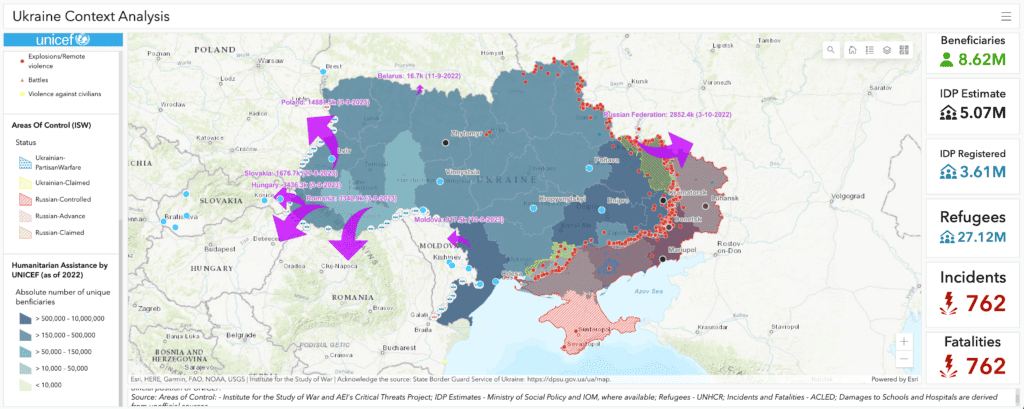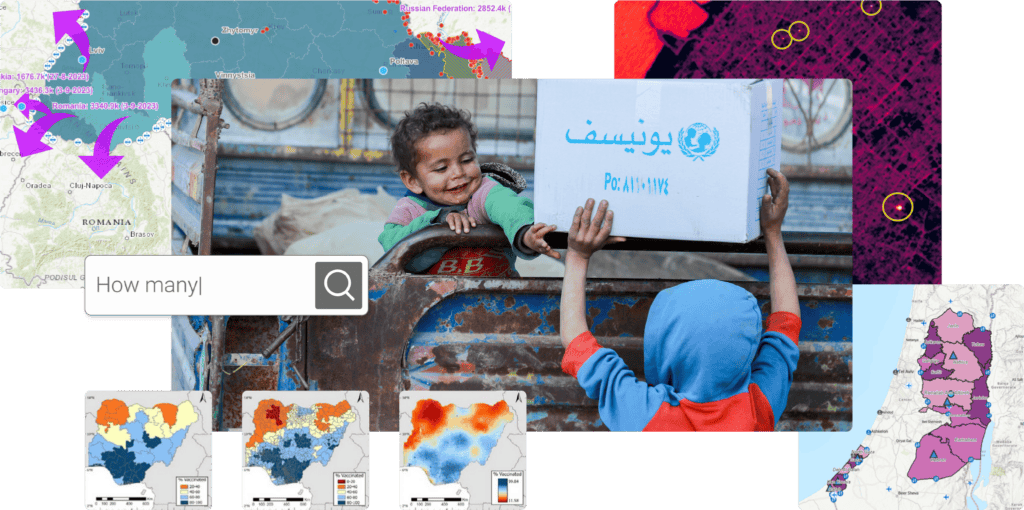The potential of new data technologies like Artificial Intelligence, machine learning, remote sensing, and geospatial analysis to improve critical humanitarian and development work is immense. While these innovative technologies and skills are becoming commonplace in other sectors, they still represent the “frontier” of what’s available in humanitarian and development work. That’s why UNICEF launched the Frontier Data Network (FDN) – a new initiative to facilitate to ethically and responsibly leverage data science and data technologies for UNICEF and partners.
Realtime channels for understanding and prioritizing the needs of children
“If there is no data, there can be no development; and in the humanitarian space, [data are] about saving lives,” said UNICEF’s Deputy Executive Director (DED) Kitty Van Der Heijden at a recent panel, moderated by journalist Esther Paniagua, addressing the gap between frontier technologies and the humanitarian and development sectors. “Thirty years ago,” DED Van Der Heijden reflected, “we had to walk for days to get to the mountain where an earthquake occurred, look around for what infrastructure was still standing, figure out how many children were in need… and then walk all the way back to send a fax reporting on needs: tarps, drinking water, food.”
Today, DED Van Der Heijden observed, “we can see the damage as it happens” using satellite images, social media analysis, and rapid surveys on the ground. By interpreting these data, we can now determine more quickly than ever which schools are damaged, which health facilities are still standing, or which drinking water facilities are still functioning. The result: UNICEF and its partners are able to prioritize relief efforts for the children with greatest needs.
We have seen the critical potential of frontier data technologies in our responses to recent crises like Ukraine or Gaza where geospatial technologies, satellite imagery, AI and other frontier data tech combined have allowed us to identify and respond much faster to critical needs of vulnerable children.
Unfortunately, the technology and talent needed to perform this kind of work remains scarce and expensive. By one estimate, the social sector alone will need 3.5 million data scientists over the next 10 years – not to mention digitalization of fundamental systems – to achieve its goals. With limited resources, hiring millions of new staff is impossible; that’s why UNICEF has taken a different approach.

In response to the challenges posed by unreliable data collection during emergencies, FDN leveraged new sources and approaches to obtain the most updated estimations for damage assessment and population displacement. Collaborating with scientists from leading universities, FDN utilized social media advertising data from Meta, satellite imagery from UNOSAT and mobility data to provide near real-time data on population displacement, enabling targeted humanitarian responses in Ukraine.
A Networked Solution
To bridge the digital skills and technology gap, UNICEF is building a global community from across the private sector, academic research centers, and the front lines of the humanitarian world – where these skills are needed most.
Over 300 staff and partners are already engaged in the early stages of the Frontier Data Network across 60+ countries and multiple disciplines. Participants are collaborating on dozens of projects that leverage data in new ways to drive results for children. These “big data” pilots and data analytics projects not only improve UNICEF’s ability to respond to existing crises but also help staff predict and better prepare for future impacts on vulnerable children—such as impacts from floods, droughts, or conflict.
The potential of these technologies, when integrated with existing systems, offer a new hope for dealing with some of the most critical and growing challenges affecting children from conflict to epidemics or climate change.
However, frontier data technologies can also lead to wrong decision making. “These new applications of data science can easily exacerbate and systematize inequalities and leave behind the most vulnerable, especially children who are rarely represented in big data, if we are not careful.” observes Manuel Garcia-Herranz, principal researcher of the Frontier Data Network. For example, epidemic models using mobile phone data that fail to correct for bias (e.g. not everyone has a phone) could incorrectly influence crisis planning by suggesting that epidemics will reach wealthier areas.
“This is why it is so critical to ensure that new data science technologies and methods are developed based on the needs of the most vulnerable: with more attention to data bias, algorithmic equity, and the “last mile” of humanitarian and development efforts,” says Garcia-Herranz. The application of frontier data and technology to the humanitarian sector is just as new for data scientists as it is for practitioners on the ground. Building these new skills and capabilities requires new talent exchange and talent creation opportunities—to help define key problems of the most vulnerable in machine learning and computer science terms and to integrate these new methods into existing humanitarian and development programs.”
Unlike traditional capacity building approaches, the Frontier Data Network aims to provide staff on the front lines with a network of resources, relationships, and talent. At the same time, the FDN will offer global technology experts a direct path to making a sustained impact in the world.
“The strength of the Frontier Data Network lies in the local and regional engagement,” says FDN team member Viviana Canon Tamayo. “By centering the needs and experiences of colleagues or even government partners on the frontlines, we are able to collectively apply technology to solve real-world challenges, rather than tech or data solutions in search of problem.”
Watch this short video to learn more:
Get involved
The Frontier Data Network is only as strong as its partners across the public and private sectors, research centers, and the entire UN system. “Without partnering with the private sector and academia,” DED Van Der Heijden notes, “we cannot access and interpret that data, work with it, and connect it to the right policy decisions. That is what the FDN allows us to do.”
“This takes our data technology community another step forward in pushing frontier approaches to the generation of rapid, granular data for fast breaking crises,” observes Frontier Data Technology Unit chief Yves Jacques, commenting on the Government of Spain’s pioneering investment in the Frontier Data Network.
Director of the Spanish Agency for International Development Cooperation (AECID) Antón Leis explained the vision behind this investment in the FDN. “I believe that, as humanitarian and development actors, our role is to collaborate with the technology sector. We are also geeks — development geeks —so it’s time to get both communities to start talking to each other.” The Frontier Data Network is a critical vehicle for facilitating this much-needed collaboration across sectors and disciplines.

